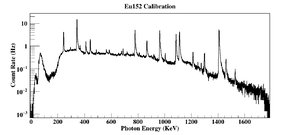Difference between revisions of "CH HPGe Efficiency"
| Line 18: | Line 18: | ||
<math> (line\ intensity)\ (incident\ thermal\ neutrons\ per\ second)\ (\sigma_{total})\ (MCNP\ fudge\ factor\ from\ Paul\ approx\ 4)\ =\ Theoretical\ Rate </math> | <math> (line\ intensity)\ (incident\ thermal\ neutrons\ per\ second)\ (\sigma_{total})\ (MCNP\ fudge\ factor\ from\ Paul\ approx\ 4)\ =\ Theoretical\ Rate </math> | ||
| + | |||
| + | For the ease of calculation, I will use the outgoing photon rate from the Gd foil as tabulated by MCNP, thanks to Paul Stonaha. The number given was into 2pi, towards the HPGe detector, multiplying by 2 should give the rate into 4pi. | ||
| + | |||
| + | The 897 KeV peak found in the Gd in/out measurements can be attributed to two different lines created by neutron capture on Gd157. The high purity germanium detector used in this experiment would not be able to resolve the two distinct lines as the resolution is not fine enough. However, adding the intensities together should yield the theoretical rate for the peak measured at that energy. | ||
| + | |||
| + | The first peak is 897.506 KeV with a relative intensity of 17.846%, according the capgam nndc data repository. | ||
| + | |||
| + | The second peak is 897.62 KeV with a relative intensity of 16%, according the capgam nndc data repository. | ||
| + | |||
| + | (0.17846 + 0.16) (2*1374Hz) (234000) = Rate | ||
Note: the ''fudge factor'' comes from the nucleus being excited and then de-exciting from the neutron absorption and emits on average, 4 photons per neutron capture | Note: the ''fudge factor'' comes from the nucleus being excited and then de-exciting from the neutron absorption and emits on average, 4 photons per neutron capture | ||
Revision as of 19:56, 29 September 2021
Eu152 Calibration
- HPGe calibrated using Eu152 source
As of 9/28/21
The calibration used to map from ADC channel number to KeV is:
Where x = channel 9 of the ADC and is input as PADC.PADC785N[9].
Total Efficiency
This is total efficiency using the Gadolinium foil as the source.
For the ease of calculation, I will use the outgoing photon rate from the Gd foil as tabulated by MCNP, thanks to Paul Stonaha. The number given was into 2pi, towards the HPGe detector, multiplying by 2 should give the rate into 4pi.
The 897 KeV peak found in the Gd in/out measurements can be attributed to two different lines created by neutron capture on Gd157. The high purity germanium detector used in this experiment would not be able to resolve the two distinct lines as the resolution is not fine enough. However, adding the intensities together should yield the theoretical rate for the peak measured at that energy.
The first peak is 897.506 KeV with a relative intensity of 17.846%, according the capgam nndc data repository.
The second peak is 897.62 KeV with a relative intensity of 16%, according the capgam nndc data repository.
(0.17846 + 0.16) (2*1374Hz) (234000) = Rate
Note: the fudge factor comes from the nucleus being excited and then de-exciting from the neutron absorption and emits on average, 4 photons per neutron capture
Then find detected rate using HPGe
Divide (detected rate) by (theoretical rate) for total detector efficiency
